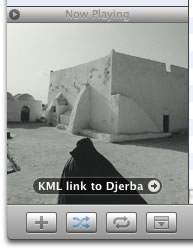 I got to thinking today as to whether there might be ways to integrate podcasts with Google Earth, so that you could narrate a trip, for example, and have Google Earth show you precisely what it is you’re talking about, while you’re talking about it.
I got to thinking today as to whether there might be ways to integrate podcasts with Google Earth, so that you could narrate a trip, for example, and have Google Earth show you precisely what it is you’re talking about, while you’re talking about it.
It turns out that you can, if you use some of the more advanced features that podcasts have these days — namely, chapters, and the ability to link chapters to URLs. The trick is linking to a KML file instead of an HTML file. It works perfectly, and I’ve made a proof of concept.
Some caveats, of course. This looks best in iTunes (Windows or Mac), though it also works in QuickTime (Windows or Mac) and in embedded QuickTime web objects. [Update: WIndows users will need the very latest QuickTime install.] ]If you use another client, I don’t think you will see the clickable links. The file is the newer .m4a format, which lets you embed metadata. I used Apple’s GarageBand to record my voice, create chapters, add the URLs, URL titles, and image thumbnails. Your mileage may vary with other authoring tools, but you can also do all this manually. All these enhancements are on the cusp of going mainstream.
The best way to see how this works is to just download the podcast file to iTunes, or else watch the Podcast as an embedded web object — it’s less than two minutes long. It also helps to already have Google Earth up and running. (This works very well, BTW, from within Google Earth’s own web browser.)
When links appear at the bottom of the podcast “art”, click on them to fetch the KML file. If your browser is already trained to open KML files automatically in Google Earth, then you’re fine. Otherwise, you’ll have to point it there. Tip: Once in Google Earth, click on the placemark to see the full-size view of the photographs I’m discussing.
No, you can’t script Google Earth so that the podcast can instruct it to fly to places automatically.
There are some rough edges with something this new: The KML files are first saved to your downloaded folder/desktop, so it gets a bit littered there eventually. And it would also be simpler if we could download just one big KML file and then link to specific placemarks or layer views within it, in a manner similar to how we can append “#element-name” to HTML documents to access elements within an HTML document. (Best of all, of course, would be that we could write anchor tags that link directly to locations and views inside Google Earth. But that’s another story.)
[Update 22:47 UTC: One last thing: You’re not restricted to just placemarks. You could also link to 3D models and have yourself a very cool architecture podcast, for example.]

Stefan, nice proof-of-concept. It is interesting having other medias link to and from GE. This just adds further support for thinking of KML files as another form of web content like HTML, XML, etc.
By the way, I had to update to the latest version of Quicktime to get the HTML link to work properly under Windows XP. I was using a version of QT from just 6 months ago.
Here is an example, how to use audio annotations in GE’s Placemarks (click the Placemarks):
http://www.magnalox.net/mlxlogdownload.php?fmt=KML&lid=11696
You don’t need no extra software except Flash, Quicktime on Windows is not always a pleasant surprise.
You can author such .kmz files using magnalox by uploading the files and then drop them in at the right locations (as with images).
If someone found a better way (whithout opening a browserwindow) to integrate audio into GE, just let me know (email function on magnalox).
…not exactly what You did, but a similar subject.
Hi Volker,
There also seems to be a bug in the Mac version that doesn’t let you click on links such as that of the arrow. The KMZ file with glaciers from last week had the same problem: a tags around img tags didn’t work
Thanks for the hint, Stefan.
How was this resolved in the glaciers KMZ ?
I could replace the image by text, but then the “beauty” of the solution would also disappear.
The links are in
Placemark 1:
http://www.magnalox.net/log/no.php?fmt=r&lid=11696&name=introsound01.mp3
Placemark 10:
http://www.magnalox.net/log/no.php?fmt=r&lid=11696&name=Aufnahme8.mp3
and so on.
I have only little feedback from Mac users, there aren’t that many.
It may happen that my next PC wil be a Mac, now that there are new opportunities.
Volker
It wasn’t resolved:-) For now, I would suggest adding a text link (which works) below the image. Not pretty, but it works.
Yes, Macs are gorgeous.